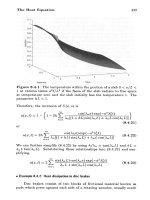advanced engineering mathematics – mathematics
Bạn đang xem bản rút gọn của tài liệu. Xem và tải ngay bản đầy đủ của tài liệu tại đây (127.92 KB, 40 trang )
<span class='text_page_counter'>(1)</span><div class='page_container' data-page=1>
<b>Introduction to Time Series Analysis. Lecture 6.</b>
<b>Peter Bartlett</b>
www.stat.berkeley.edu/<sub>∼</sub>bartlett/courses/153-fall2010
Last lecture:
1. Causality
2. Invertibility
3. AR(p) models
</div>
<span class='text_page_counter'>(2)</span><div class='page_container' data-page=2>
<b>Introduction to Time Series Analysis. Lecture 6.</b>
<b>Peter Bartlett</b>
www.stat.berkeley.edu/<sub>∼</sub>bartlett/courses/153-fall2010
1. ARMA(p,q) models
2. Stationarity, causality and invertibility
3. The linear process representation of ARMA processes: ψ.
4. Autocovariance of an ARMA process.
</div>
<span class='text_page_counter'>(3)</span><div class='page_container' data-page=3>
<b>Review: Causality</b>
A linear process <sub>{</sub>Xt} <b>is causal (strictly, a causal function</b>
<b>of</b> <sub>{</sub>Wt}) if there is a
ψ(B) = ψ<sub>0</sub> + ψ<sub>1</sub>B + ψ<sub>2</sub>B2 + <sub>· · ·</sub>
with
∞
X
j=0
|ψj| < ∞
</div>
<span class='text_page_counter'>(4)</span><div class='page_container' data-page=4>
<b>Review: Invertibility</b>
A linear process <sub>{</sub>Xt} <b>is invertible (strictly, an invertible</b>
<b>function of</b> <sub>{</sub>Wt}) if there is a
π(B) = π<sub>0</sub> + π<sub>1</sub>B + π<sub>2</sub>B2 + <sub>· · ·</sub>
with
∞
X
j=0
|πj| < ∞
</div>
<span class='text_page_counter'>(5)</span><div class='page_container' data-page=5>
<b>Review: AR(p), Autoregressive models of order</b>
p
<b>An AR(p) process</b> <sub>{</sub>Xt} is a stationary process that satisfies
Xt − φ1Xt−1 − · · · − φpXt−p = Wt,
where <sub>{</sub>Wt} ∼ W N(0, σ2).
Equivalently, φ(B)Xt = Wt,
</div>
<span class='text_page_counter'>(6)</span><div class='page_container' data-page=6>
<b>Review: AR(p), Autoregressive models of order</b>
p
<i><b>Theorem: A (unique) stationary solution to</b></i> φ(B)Xt = Wt
exists iff the roots of φ(z) <i>avoid the unit circle:</i>
|z<sub>|</sub> = 1 <sub>⇒</sub> φ(z) = 1 <sub>−</sub> φ1z − · · · − φpzp 6= 0.
<i>This AR(p) process is causal iff the roots of</i> φ(z) <i>are outside</i>
the unit circle:
</div>
<span class='text_page_counter'>(7)</span><div class='page_container' data-page=7>
<b>Reminder: Polynomials of a complex variable</b>
Every degree p polynomial a(z) can be factorized as
a(z) = a<sub>0</sub> + a<sub>1</sub>z + <sub>· · ·</sub> + apzp = ap(z − z1)(z − z2)· · ·(z − zp),
where z<sub>1</sub>, . . . , zp ∈ C <i>are the roots of</i> a(z). If the coefficients a0, a1, . . . , ap
are all real, then the roots are all either real or come in complex conjugate
pairs, zi = ¯zj.
<b>Example:</b> z + z3 = z(1 + z2) = (z <sub>−</sub> 0)(z <sub>−</sub> i)(z + i),
that is, z1 = 0, z2 = i, z3 = −i. So z1 ∈ R; z2, z3 6∈ R; z2 = ¯z3.
Recall notation: A complex number z = a + ib has Re(z) = a, Im(z) = b,
¯
z = a <sub>−</sub> ib, <sub>|</sub>z<sub>|</sub> = √a2 + b2, arg(z) = tan−1
</div>
<span class='text_page_counter'>(8)</span><div class='page_container' data-page=8>
<b>Review: Calculating</b>
ψ
<b>for an AR(p): general case</b>
φ(B)Xt = Wt, ⇔ Xt = ψ(B)Wt
so 1 = ψ(B)φ(B)
⇔ 1 = (ψ0 + ψ1B + · · ·)(1 − φ1B − · · · − φpBp)
⇔ 1 = ψ0, 0 = ψj (j < 0),
0 = φ(B)ψj (j > 0).
<i>We can solve these linear difference equations in several ways:</i>
• numerically, or
• by guessing the form of a solution and using an inductive proof, or
</div>
<span class='text_page_counter'>(9)</span><div class='page_container' data-page=9>
<b>Introduction to Time Series Analysis. Lecture 6.</b>
1. Review: Causality, invertibility, AR(p) models
2. ARMA(p,q) models
3. Stationarity, causality and invertibility
4. The linear process representation of ARMA processes: ψ.
5. Autocovariance of an ARMA process.
</div>
<span class='text_page_counter'>(10)</span><div class='page_container' data-page=10>
<b>ARMA(p,q): Autoregressive moving average models</b>
<b>An ARMA(p,q) process</b> <sub>{</sub>Xt} is a stationary process that
satisfies
Xt−φ1Xt−1−· · ·−φpXt−p = Wt+θ1Wt−1+· · ·+θqWt−q,
where <sub>{</sub>Wt} ∼ W N(0, σ2).
• AR(p) = ARMA(p,0): θ(B) = 1.
</div>
<span class='text_page_counter'>(11)</span><div class='page_container' data-page=11>
<b>ARMA(p,q): Autoregressive moving average models</b>
<b>An ARMA(p,q) process</b> <sub>{</sub>Xt} is a stationary process that
satisfies
Xt−φ1Xt−1−· · ·−φpXt−p = Wt+θ1Wt−1+· · ·+θqWt−q,
where <sub>{</sub>Wt} ∼ W N(0, σ2).
Usually, we insist that φp, θq 6= 0 and that the polynomials
φ(z) = 1 <sub>−</sub> φ<sub>1</sub>z <sub>− · · · −</sub> φpzp, θ(z) = 1 + θ1z + · · · + θqzq
</div>
<span class='text_page_counter'>(12)</span><div class='page_container' data-page=12>
<b>ARMA(p,q): An example of parameter redundancy</b>
Consider a white noise process Wt. We can write
Xt = Wt
⇒ Xt − Xt−1 + 0.25Xt−2 = Wt − Wt−1 + 0.25Wt−2
(1 <sub>−</sub> B + 0.25B2)Xt = (1 − B + 0.25B2)Wt
This is in the form of an ARMA(2,2) process, with
</div>
<span class='text_page_counter'>(13)</span><div class='page_container' data-page=13>
<b>ARMA(p,q): An example of parameter redundancy</b>
ARMA model: φ(B)Xt = θ(B)Wt,
with φ(B) = 1 <sub>−</sub> B + 0.25B2,
θ(B) = 1 <sub>−</sub> B + 0.25B2
Xt = ψ(B)Wt
⇔ ψ(B) = θ(B)
φ(B) = 1.
</div>
<span class='text_page_counter'>(14)</span><div class='page_container' data-page=14>
<b>Introduction to Time Series Analysis. Lecture 6.</b>
1. Review: Causality, invertibility, AR(p) models
2. ARMA(p,q) models
3. Stationarity, causality and invertibility
4. The linear process representation of ARMA processes: ψ.
5. Autocovariance of an ARMA process.
</div>
<span class='text_page_counter'>(15)</span><div class='page_container' data-page=15>
<b>Recall: Causality and Invertibility</b>
A linear process <sub>{</sub>Xt} <b>is causal if there is a</b>
ψ(B) = ψ<sub>0</sub> + ψ<sub>1</sub>B + ψ<sub>2</sub>B2 + <sub>· · ·</sub>
with
∞
X
j=0
|ψj| < ∞ and Xt = ψ(B)Wt.
<b>It is invertible if there is a</b>
π(B) = π<sub>0</sub> + π<sub>1</sub>B + π<sub>2</sub>B2 + <sub>· · ·</sub>
with
∞
X
j=0
</div>
<span class='text_page_counter'>(16)</span><div class='page_container' data-page=16>
<b>ARMA(p,q): Stationarity, causality, and invertibility</b>
<b>Theorem: If</b> φ and θ <i>have no common factors, a (unique) </i>
<i>sta-tionary solution to</i> φ(B)Xt = θ(B)Wt exists iff the roots of
φ(z) <i>avoid the unit circle:</i>
|z<sub>|</sub> = 1 <sub>⇒</sub> φ(z) = 1 <sub>−</sub> φ<sub>1</sub>z <sub>− · · · −</sub> φpzp 6= 0.
<i>This ARMA(p,q) process is causal iff the roots of</i> φ(z) <i>are </i>
<i>out-side the unit circle:</i>
|z<sub>| ≤</sub> 1 <sub>⇒</sub> φ(z) = 1 <sub>−</sub> φ<sub>1</sub>z <sub>− · · · −</sub> φpzp 6= 0.
<i>It is invertible iff the roots of</i> θ(z) <i>are outside the unit circle:</i>
</div>
<span class='text_page_counter'>(17)</span><div class='page_container' data-page=17>
<b>ARMA(p,q): Stationarity, causality, and invertibility</b>
Example: (1 <sub>−</sub> 1.5B)Xt = (1 + 0.2B)Wt.
φ(z) = 1 <sub>−</sub> 1.5z = <sub>−</sub>3
2
z <sub>−</sub> 2
3
,
θ(z) = 1 + 0.2z = 1
5 (z + 5).
<b>1.</b> φ and θ have no common factors, and φ’s root is at 2/3, which is not on
the unit circle, so <sub>{</sub>Xt} is an ARMA(1,1) process.
<b>2.</b> φ’s root (at 2/3) is inside the unit circle, so <sub>{</sub>Xt} <i>is not causal.</i>
</div>
<span class='text_page_counter'>(18)</span><div class='page_container' data-page=18>
<b>ARMA(p,q): Stationarity, causality, and invertibility</b>
Example: (1 + 0.25B2)Xt = (1 + 2B)Wt.
φ(z) = 1 + 0.25z2 = 1
4 z
2 <sub>+ 4</sub>
= 1
4(z + 2i)(z − 2i),
θ(z) = 1 + 2z = 2
z + 1
2
.
<b>1.</b> φ and θ have no common factors, and φ’s roots are at <sub>±</sub>2i, which is not
on the unit circle, so {Xt} is an ARMA(2,1) process.
<b>2.</b> φ’s roots (at <sub>±</sub>2i) are outside the unit circle, so <sub>{</sub>Xt} <i>is causal.</i>
</div>
<span class='text_page_counter'>(19)</span><div class='page_container' data-page=19>
<b>Causality and Invertibility</b>
<b>Theorem:</b> Let <sub>{</sub>Xt} be an ARMA process defined by
φ(B)Xt = θ(B)Wt. If all |z| = 1 have θ(z) 6= 0, then there
are polynomials φ˜ and θ˜ and a white noise sequence W˜t such
that {Xt} satisfies φ˜(B)Xt = ˜θ(B) ˜Wt, and this is a causal,
invertible ARMA process.
</div>
<span class='text_page_counter'>(20)</span><div class='page_container' data-page=20>
<b>Introduction to Time Series Analysis. Lecture 6.</b>
1. Review: Causality, invertibility, AR(p) models
2. ARMA(p,q) models
3. Stationarity, causality and invertibility
4. The linear process representation of ARMA processes: ψ.
5. Autocovariance of an ARMA process.
</div>
<span class='text_page_counter'>(21)</span><div class='page_container' data-page=21>
<b>Calculating</b>
ψ
<b>for an ARMA(p,q): matching coefficients</b>
Example: Xt = ψ(B)Wt ⇔ (1 + 0.25B2)Xt = (1 + 0.2B)Wt,
so 1 + 0.2B = (1 + 0.25B2)ψ(B)
⇔ 1 + 0.2B = (1 + 0.25B2)(ψ<sub>0</sub> + ψ<sub>1</sub>B + ψ<sub>2</sub>B2 + <sub>· · ·</sub>)
⇔ 1 = ψ<sub>0</sub>,
0.2 = ψ<sub>1</sub>,
0 = ψ<sub>2</sub> + 0.25ψ<sub>0</sub>,
0 = ψ3 + 0.25ψ1,
..
</div>
<span class='text_page_counter'>(22)</span><div class='page_container' data-page=22>
<b>Calculating</b>
ψ
<b>for an ARMA(p,q): example</b>
⇔ 1 = ψ0, 0.2 = ψ1,
0 = ψj + 0.25ψj−2 (j ≥ 2).
We can think of this as θj = φ(B)ψj, with θ0 = 1, θj = 0 for j < 0, j > q.
<i>This is a first order difference equation in the</i> ψjs.
We can use the θjs to give the initial conditions and solve it using the theory
of homogeneous difference equations.
ψj = 1, 1<sub>5</sub>,−1<sub>4</sub>,−<sub>20</sub>1 , <sub>16</sub>1 , <sub>80</sub>1 ,−<sub>64</sub>1 ,−<sub>320</sub>1 , . . .
</div>
<span class='text_page_counter'>(23)</span><div class='page_container' data-page=23>
<b>Calculating</b>
ψ
<b>for an ARMA(p,q): general case</b>
φ(B)Xt = θ(B)Wt, ⇔ Xt = ψ(B)Wt
so θ(B) = ψ(B)φ(B)
⇔ 1 + θ<sub>1</sub>B + <sub>· · ·</sub> + θqBq = (ψ0 + ψ1B + · · · )(1 − φ1B − · · · − φpBp)
⇔ 1 = ψ<sub>0</sub>,
θ1 = ψ1 − φ1ψ0,
θ2 = ψ2 − φ1ψ1 − · · · − φ2ψ0,
..
.
</div>
<span class='text_page_counter'>(24)</span><div class='page_container' data-page=24>
<b>Introduction to Time Series Analysis. Lecture 6.</b>
1. Review: Causality, invertibility, AR(p) models
2. ARMA(p,q) models
3. Stationarity, causality and invertibility
4. The linear process representation of ARMA processes: ψ.
5. Autocovariance of an ARMA process.
</div>
<span class='text_page_counter'>(25)</span><div class='page_container' data-page=25>
<b>Autocovariance functions of linear processes</b>
Consider a (mean 0) linear process <sub>{</sub>Xt} defined by Xt = ψ(B)Wt.
γ(h) = E(XtXt+h)
= E(ψ<sub>0</sub>Wt + ψ1Wt−1 + ψ2Wt−2 + · · ·)
× (ψ<sub>0</sub>Wt+h + ψ1Wt+h−1 + ψ2Wt+h−2 + · · ·)
</div>
<span class='text_page_counter'>(26)</span><div class='page_container' data-page=26>
<b>Autocovariance functions of MA processes</b>
Consider an MA(q) process <sub>{</sub>Xt} defined by Xt = θ(B)Wt.
γ(h) =
σ<sub>w</sub>2 Pq−h
j=0 θjθj+h if h ≤ q,
</div>
<span class='text_page_counter'>(27)</span><div class='page_container' data-page=27>
<b>Autocovariance functions of ARMA processes</b>
ARMA process: φ(B)Xt = θ(B)Wt.
To compute γ, we can compute ψ, and then use
</div>
<span class='text_page_counter'>(28)</span><div class='page_container' data-page=28>
<b>Autocovariance functions of ARMA processes</b>
An alternative approach:
Xt − φ1Xt−1 − · · · − φpXt−p
= Wt + θ1Wt−1 + · · · + θqWt−q,
so E((Xt − φ1Xt−1 − · · · − φpXt−p)Xt−h)
= E((Wt + θ1Wt−1 + · · · + θqWt−q)Xt−h) ,
that is, γ(h) <sub>−</sub> φ<sub>1</sub>γ(h <sub>−</sub> 1) <sub>− · · · −</sub> φpγ(h − p)
= E(θhWt−hXt−h + · · · + θqWt−qXt−h)
= σ<sub>w</sub>2
q−h
X
j=0
</div>
<span class='text_page_counter'>(29)</span><div class='page_container' data-page=29>
<b>Autocovariance functions of ARMA processes: Example</b>
(1 + 0.25B2)Xt = (1 + 0.2B)Wt, ⇔ Xt = ψ(B)Wt,
ψj =
1, 1
5,−
1
4,−
1
20,
1
16,
1
80,−
1
64,−
1
320, . . .
.
γ(h) <sub>−</sub> φ1γ(h − 1) − φ2γ(h − 2) = σ<sub>w</sub>2
q−h
X
j=0
θh+jψj
⇔γ(h) + 0.25γ(h <sub>−</sub> 2) =
σ<sub>w</sub>2 (ψ0 + 0.2ψ1) if h = 0,
0.2σ<sub>w</sub>2 ψ0 if h = 1,
</div>
<span class='text_page_counter'>(30)</span><div class='page_container' data-page=30>
<b>Autocovariance functions of ARMA processes: Example</b>
We have the homogeneous linear difference equation
γ(h) + 0.25γ(h <sub>−</sub> 2) = 0
for h <sub>≥</sub> 2, with initial conditions
γ(0) + 0.25γ(<sub>−</sub>2) = σ<sub>w</sub>2 (1 + 1/25)
γ(1) + 0.25γ(<sub>−</sub>1) = σ<sub>w</sub>2 /5.
We can solve these linear equations to determine γ.
</div>
<span class='text_page_counter'>(31)</span><div class='page_container' data-page=31>
<b>Introduction to Time Series Analysis. Lecture 6.</b>
<b>Peter Bartlett</b>
www.stat.berkeley.edu/<sub>∼</sub>bartlett/courses/153-fall2010
1. ARMA(p,q) models
2. Stationarity, causality and invertibility
3. The linear process representation of ARMA processes: ψ.
4. Autocovariance of an ARMA process.
</div>
<span class='text_page_counter'>(32)</span><div class='page_container' data-page=32>
<b>Difference equations</b>
<b>Examples:</b>
xt − 3xt−1 = 0 (first order, linear)
xt − xt−1xt−2 = 0 (2nd order, nonlinear)
xt + 2xt−1 − x
2
</div>
<span class='text_page_counter'>(33)</span><div class='page_container' data-page=33>
<b>Homogeneous linear diff eqns with constant coefficients</b>
a<sub>0</sub>xt + a1xt−1 + · · · + akxt−k = 0
⇔ a<sub>0</sub> + a<sub>1</sub>B + <sub>· · ·</sub> + akBk
xt = 0
⇔ a(B)xt = 0
auxiliary equation: a0 + a1z + · · · + akzk = 0
⇔ (z <sub>−</sub> z1)(z − z2)· · · (z − zk) = 0
where z1, z2, . . . , zk ∈ C <i>are the roots of this characteristic polynomial.</i>
Thus,
</div>
<span class='text_page_counter'>(34)</span><div class='page_container' data-page=34>
<b>Homogeneous linear diff eqns with constant coefficients</b>
a(B)xt = 0 ⇔ (B − z1)(B − z2)· · ·(B − zk)xt = 0.
So any <sub>{</sub>xt} satisfying (B −zi)xt = 0 for some i also satisfies a(B)xt = 0.
Three cases:
1. The zi are real and distinct.
2. The zi are complex and distinct.
</div>
<span class='text_page_counter'>(35)</span><div class='page_container' data-page=35>
<b>Homogeneous linear diff eqns with constant coefficients</b>
<b>1. The</b> zi <b>are real and distinct.</b>
a(B)xt = 0
⇔ (B <sub>−</sub> z<sub>1</sub>)(B <sub>−</sub> z<sub>2</sub>) <sub>· · ·</sub>(B <sub>−</sub> zk)xt = 0
⇔ xt is a linear combination of solutions to
(B <sub>−</sub> z<sub>1</sub>)xt = 0, (B − z2)xt = 0, . . . , (B − zk)xt = 0
⇔ xt = c1z
−t
1 + c2z
−t
2 + · · · + ckz
−t
k ,
</div>
<span class='text_page_counter'>(36)</span><div class='page_container' data-page=36>
<b>Homogeneous linear diff eqns with constant coefficients</b>
<b>1. The</b> zi <b>are real and distinct. e.g.,</b> z1 = 1.2, z2 = −1.3
−0.6
−0.4
−0.2
0
0.2
0.4
0.6
0.8
1
c
1 z1
−t
+ c
2 z2
−t
c
1=1, c2=0
c
1=0, c2=1
c
</div>
<span class='text_page_counter'>(37)</span><div class='page_container' data-page=37>
<b>Reminder: Complex exponentials</b>
a + ib = reiθ = r(cosθ + isinθ),
where r = <sub>|</sub>a + ib<sub>|</sub> = pa2 <sub>+</sub> <sub>b</sub>2
θ = tan−1
b
a
∈ (<sub>−</sub>π, π].
Thus, r<sub>1</sub>eiθ1r
</div>
<span class='text_page_counter'>(38)</span><div class='page_container' data-page=38>
<b>Homogeneous linear diff eqns with constant coefficients</b>
<b>2. The</b> zi <b>are complex and distinct.</b>
As before, a(B)xt = 0
⇔ xt = c1z
−t
1 + c2z
−t
2 + · · · + ckz
−t
k .
If z<sub>1</sub> <sub>6∈</sub> R<sub>, since</sub> <sub>a</sub><sub>1</sub><sub>, . . . , a</sub><sub>k</sub> <sub>are real, we must have the complex conjugate</sub>
root, zj = ¯z1. And for xt to be real, we must have cj = ¯c1. For example:
xt = c z
−t
1 + ¯c z¯1
−t
= r eiθ<sub>|</sub>z1|
−t
e−iωt
+ r e−iθ
|z1|
−t
eiωt
= r<sub>|</sub>z<sub>1</sub><sub>|</sub>−t
ei(θ−ωt)
+ e−i(θ−ωt)
= 2r<sub>|</sub>z<sub>1</sub><sub>|</sub>−t
</div>
<span class='text_page_counter'>(39)</span><div class='page_container' data-page=39>
<b>Homogeneous linear diff eqns with constant coefficients</b>
<b>2. The</b> zi <b>are complex and distinct. e.g.,</b> z1 = 1.2 + i, z2 = 1.2 − i
−0.8
−0.6
−0.4
−0.2
0
0.2
0.4
0.6
0.8
1
c
1 z1
−t
+ c
2 z2
−t
</div>
<span class='text_page_counter'>(40)</span><div class='page_container' data-page=40>
<b>Homogeneous linear diff eqns with constant coefficients</b>
<b>2. The</b> zi <b>are complex and distinct. e.g.,</b> z1 = 1 + 0.1i, z2 = 1 − 0.1i
−1.5
−1
−0.5
0
0.5
1
1.5
2
c
1 z1
−t
+ c
2 z2
−t
</div>
<!--links-->









